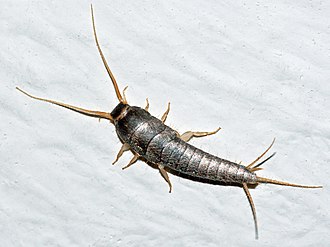Silverfish

The silverfish (Lepisma saccharinum) is a species of small, primitive, wingless insect in the order Zygentoma (formerly Thysanura). Its common name derives from the animal’s silvery light grey colour, combined with the fish-like appearance of its movements. The scientific name (L. saccharinum) indicates that the silverfish’s diet consists of carbohydrates such as sugar or starches. While the common name silverfish is used throughout the global literature to refer to various species of Zygentoma, the Entomological Society of America restricts use of the term solely for Lepisma saccharinum.[1]
The silverfish is a nocturnal insect typically 13–25 mm (0.5–1.0 in) long.[2] Its abdomen tapers at the end, giving it a fish-like appearance.[3] The newly hatched are whitish, but develop a greyish hue and metallic shine as they get older.[4] It has two long cerci and one terminal filament at the tip of the abdomen between the cerci. It also has two small compound eyes, although other members of Zygentoma are completely eyeless, such as the family Nicoletiidae.[3][5]
Like other species in Apterygota, the silverfish is completely wingless.[3][6] It has long antennae, and moves in a wiggling motion that resembles the movement of a fish.[7] This, coupled with its appearance and silvery scales, inspires its common name. Silverfish can regenerate terminal filaments and antennae, if lost, in two to four weeks.[8] Silverfish typically live for up to three years.[9]
The silverfish is an agile runner and can outrun most of its predators (including wandering spiders and centipedes). However, such running is possible only on horizontal surfaces, as it lacks any additional appendages, and therefore is not fast enough to climb walls at the same speed.[citation needed] It also avoids light.[10]
Silverfish are a cosmopolitan species, found in Africa, the Americas, Australia, Eurasia, and other parts of the Pacific.[11] They inhabit moist areas, requiring a relative humidity between 75% and 95%.[12] In urban areas, they can be found in attics, basements, bathtubs, sinks, kitchens, old books, classrooms, and showers.[4]
Before silverfish reproduce, they carry out a ritual involving three phases, which may last over half an hour. In the first phase, the male and female stand face to face, their quivering antennae touching, then repeatedly back off and return to this position. In the second phase, the male runs away and the female chases him. In the third phase, the male and female stand side by side and head to tail, with the male vibrating his tail against the female.[13] Finally, the male lays a spermatophore, a sperm capsule covered in gossamer, which the female takes into her body via her ovipositor to fertilize her eggs. The female lays groups of fewer than 60 eggs at once, deposited in small crevices.[14] The eggs are oval-shaped, whitish, about 0.8 mm (0.031 in) long,[15] and take between two weeks and two months to hatch. A silverfish usually lays fewer than 100 eggs in her lifetime.[2]
When the nymphs hatch, they are whitish in colour, and look like smaller adults. As they moult, young silverfish develop a greyish appearance and a metallic shine, eventually becoming adults after three months to three years.[14] They may go through 17 to 66 moults in their lifetimes, sometimes 30 in a single year—many more than most insects. Silverfish are among the few types of insect that continue to moult after reaching adulthood.[16]
